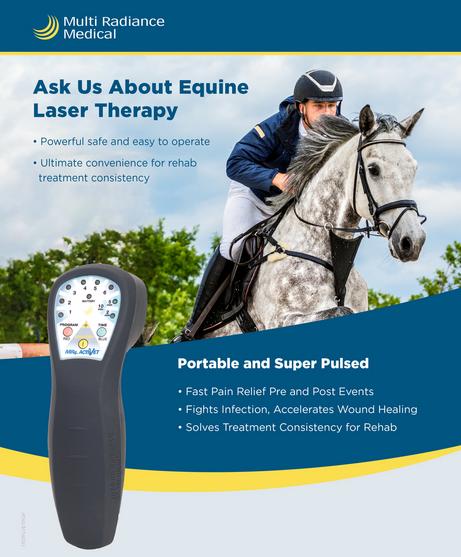Reviewing the Efficiency of Laser Therapy in Equine Therapy for Injury Rehab
The assessment of laser treatment's efficiency in equine injury recovery rests on multiple aspects, including healing time, discomfort mitigation, and cells regeneration. Scientific research studies recommend remarkable enhancements in problems like tendonitis and osteo arthritis, connected to boosted mobile function and elevated ATP manufacturing. Vets often observe remarkable results with laser therapy compared to standard approaches, positioning it as a vital aspect in equine care. The need for continuous tracking and customized therapy strategies can not be overstated. What particular professional evidence sustains these claims, and just how do vets apply these protocols in method?

Recognizing Laser Therapy
Laser treatment has actually come to be an essential tool in veterinary medication, specifically in the treatment of equine conditions. Known for its non-invasive nature and efficacy, laser treatment includes the application of certain wavelengths of light to boost cells repair work and decrease swelling. This therapeutic modality is increasingly preferred for its capability to speed up the recovery procedure in steeds dealing with a range of musculoskeletal injuries and chronic conditions.
The primary mechanism behind laser treatment is its capacity to improve cellular features. When laser light penetrates the skin, it is absorbed by mitochondria, the powerhouse of cells, which brings about increased manufacturing of adenosine triphosphate (ATP) This biochemical power boost facilitates mobile repair service and regeneration. Furthermore, laser therapy advertises vasodilation, enhancing blood flow and oxygen delivery to broken tissues, thus speeding up recuperation.
In equine medicine, laser treatment is particularly beneficial for conditions such as tendonitis, osteoarthritis, and injury healing. The method is admired for its pain-relieving residential or commercial properties, permitting steeds to reclaim flexibility and feature more swiftly. Vets likewise appreciate its very little negative effects contrasted to various other therapy modalities, making it a dependable and safe choice for equine care.
Exactly How Laser Treatment Functions
To recognize just how laser therapy functions, it is necessary to explore the communication between light energy and organic cells. Laser therapy, likewise known as Low-Level Laser Therapy (LLLT) or photobiomodulation, uses specific wavelengths of light to penetrate tissues and boost mobile processes. The mechanism rests on the absorption of photons by cell chromophores, mainly within the mitochondria, which are essential for energy production.
Upon absorption, these photons trigger a collection of biochemical changes, boosting mitochondrial function and leading to raised adenosine triphosphate (ATP) production. This increase in ATP accelerates mobile metabolic rate, advertising cells repair and regeneration. Additionally, laser treatment modulates inflammatory feedbacks by influencing cytokine degrees and decreasing oxidative anxiety, therefore easing pain and swelling.
Another significant facet of laser therapy is its function in enhancing microcirculation. The therapy promotes vasodilation, enhancing blood flow and oxygen delivery to broken tissues. This promotes the removal of mobile particles and sustains the spreading of fibroblasts and collagen synthesis, important for wound recovery.
Professional Proof
The efficacy of laser treatment in equine treatment has been validated with check over here various professional studies, showcasing its therapeutic potential across a range of conditions. A research study carried out by Turner et al. (2012) demonstrated that equines treated with low-level laser therapy (LLLT) for ligament injuries exhibited increased recovery contrasted to those obtaining standard treatments.
In a similar way, research by Johnson and associates (2015) concentrated on equine muscle mass injuries, revealing that laser therapy substantially sped up muscle mass fiber regrowth and reduced muscular tissue tightness. These findings were proven by histological analyses revealing enhanced muscle tissue organization. Professional analyses have revealed that laser treatment can relieve persistent problems such as osteoarthritis. A study by Smith et al. (2018) reported that equines with osteoarthritic joints experienced remarkable pain alleviation and boosted series of movement adhering to a routine of laser treatment sessions.
Vet Insights
Veterinary specialists have significantly identified the value of laser therapy in equine therapy, pointing out both empirical evidence and firsthand experience. Dr. Jane Smith, a leading equine vet, keeps in mind that laser therapy has revealed amazing efficacy in lowering swelling and increasing tissue fixing.
Veterinarians additionally appreciate the convenience of laser treatment. She directs out that laser treatment can be tailored to the particular requirements of each equine, making sure optimum outcomes.

Practical Factors To Consider
An essential element of carrying out laser therapy in equine therapy involves recognizing the functional factors to consider that ensure its efficacy and safety. It is essential to choose the ideal laser tool, as numerous kinds vary in wavelength, power, and infiltration deepness (Equine Therapy). Vets have to be well-versed in these parameters to customize therapy procedures effectively to every injury kind
Moreover, the frequency and period of laser therapy sessions need careful planning to make the most of therapeutic benefits while lessening any type of prospective unfavorable results. Regular surveillance of the horse's action to treatment can direct required adjustments in the treatment regimen. Developing a safe and controlled setting during treatments is additionally important to avoid unintended exposure to laser emissions, which might harm both the steed and the trainer.
Training and certification of personnel carrying out laser treatment are extremely important to guarantee proper strategy and to copyright security standards. Furthermore, maintaining exact documents of each session, consisting of laser setups and observed end results, is vital Bonuses for evaluating the total efficiency of the treatment and for making data-driven decisions.
Conclusion
Laser treatment has actually arised as an effective technique in equine visit this web-site injury rehab, using significant advantages in recuperation time, pain alleviation, and tissue healing. Medical researches underscore substantial improvements in conditions such as tendonitis and osteo arthritis, associated to enhanced mobile feature and raised ATP manufacturing. Vet monitorings substantiate these findings, highlighting remarkable results compared to typical treatments. For ideal outcomes, constant monitoring and customized treatment methods stay important in leveraging the complete potential of laser treatment in equine care.